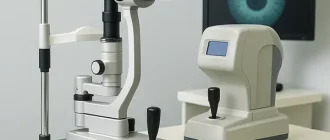Have you ever noticed a sudden black spot in your vision? Or perhaps zigzagging white lines dancing across your field of view? Sometimes it may look like shimmering “heat waves” at the edge of your sight, almost like sunlight reflecting off hot asphalt.
How long do zigzag/jagged vision symptoms usually last?
Each bar shows the average duration on a 0–60 minute scale. Persistent symptoms require urgent attention.
Ocular Migraine
15–60 min (avg ~30)
Brief visual aura with shimmering zigzags, heat-wave ripples, or a dark spot; may occur with or without headache and usually resolves within an hour.
Transient Ischemic Attack (TIA)
5–15 min (avg ~10)
Sudden negative visual loss or dimming, often with neurologic signs (numbness, weakness, speech changes); a red-flag event needing immediate medical evaluation.
Visual Aura with Migraine Headache
20–60 min (avg ~40)
Gradually expanding zigzag lines (scintillating scotoma) followed by pulsating head pain, light/sound sensitivity, and possible nausea.
Retinal Tear or Detachment Symptoms
Persistent / progressive
New flashes and a shower of floaters, a gray curtain or shadow creeping across vision—does not self-resolve and demands urgent ophthalmic care.
Source: eyexan.com
Jagged Lines in a Vision: Causes and Symptoms
If you have, you may have been experiencing what is referred to as an ocular migraine. Ocular migraines take place when capillary spasm in the visual center of the brain (the occipital lobe) or the retina.
According to the American Academy of Ophthalmology ⧉, ocular migraines are not considered dangerous in most cases, but they can mimic other, more serious conditions. That’s why ophthalmologists often recommend a detailed eye exam — sometimes including retinal imaging (fundus photography or OCT) — to rule out retinal tears or neurological causes.
They can take on a number of various symptoms however usually last from a few minutes to an hour. They can take on either positive or negative visual symptoms indicating they can produce what looks like a black blocked out area in your vision (negative symptom) or they can produce visual symptoms that you see however understand aren’t really there like heat waves or rugged white lines that look nearly like lightning streaks (positive symptoms).

Some individuals experience a headache after the visual disturbance, but many do not. The hallmark of this condition is that once the visual episode passes, vision typically returns to normal without lasting changes. Most episodes last around 20 minutes, although they may occasionally stretch closer to an hour.
If you have this happen for the first time it can be fairly scary and it is a good idea to have a thorough eye examination by your eye doctor or eye doctor not long after the episode to be sure there is nothing else causing the problem.
There are other things besides an ocular migraine that can trigger similar symptoms. Flashing lights and new drifting spots in your vision could be the indication of a retinal tear or detachment (see I’m seeing new floating spots in my vision, what should I do?).
Many individuals who get ocular migraines tend to have them occur in clusters. They will get 3 or four episodes within a week and after that may not have another one for numerous months or even years.
People with a personal or family history of migraines are more likely to experience ocular migraines. Motion sickness and sensitivity to bright light can also increase the likelihood of these episodes.
Risk factors for ocular migraines
Bars show approximate likelihood (%) based on patient history and studies.
Family history of migraine
~50%
Having close relatives with migraines significantly raises the risk of ocular migraine episodes.
History of motion sickness
~30%
People prone to car or sea sickness often show higher susceptibility to visual auras.
Sensitivity to bright light
~25%
Strong glare or flashing lights may trigger temporary jagged-line episodes in sensitive individuals.
Idiopathic (no clear cause)
~12%
A smaller group experiences ocular migraines without identifiable risk factors.
Source: eyexan.com
While the symptoms often cause anxiety — especially the first time they occur — ocular migraines almost never result in permanent vision loss or structural damage. As Reyus Mammadli, medical consultant, often advises, “patients should not panic, but they should not ignore persistent or unusual symptoms either.”
So if symptoms like this unexpectedly take place in your vision attempt to stay calm, pull over if you are driving, and just await them to disappear. If they persist for longer than an hour, then you need to look for immediate medical attention.
When to See a Doctor?
Of course, if you see such lines in your vision – this is an excuse to see a doctor and not to self-medicate. Contact your ophthalmologist if you find one or more of the following symptoms:
- Waves or shimmering lines in peripheral vision
- White zigzag lines across your sight
- Blurry, wavy patches blocking part of vision
- A jagged flashing line across the visual field
- Constant shimmering or mirage-like effects
- Visual waves combined with headache
- New floaters or flashing lights
Average cost of common eye-related tests in the USA
Bars show the average cost on a $0–1500 scale. Prices vary by clinic and insurance coverage.
Comprehensive Eye Exam (basic, without imaging)
$150–200 (avg ~$175)
General check of vision, eye pressure, and health of the retina and cornea. First-line test to rule out serious eye conditions.
OCT Scan (Optical Coherence Tomography)
$100–250 (avg ~$175)
High-resolution imaging of the retina, macula, and optic nerve. Essential for detecting early retinal disease or nerve damage.
Retinal Photography
$75–150 (avg ~$110)
Digital photo of the back of the eye. Helps monitor diabetic retinopathy, macular degeneration, and glaucoma progression.
Brain MRI (if neurological cause suspected)
$500–1500 (avg ~$1000)
Magnetic resonance imaging of the brain and optic pathways. Used if visual symptoms suggest stroke, TIA, or neurological disease.
Source: eyexan.com





